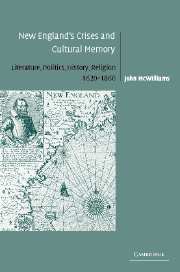Book contents
- Frontmatter
- Contents
- Acknowledgments
- Introduction: Crisis rhetoric: exclusion in New England history
- PART ONE PLANTATION AND SETTLEMENT
- PART TWO TIME OF TROUBLES
- Headnote
- 4 A cloud of blood: King Philip's War
- 5 The axe at the root of the tree: Scarlet Governors and Gray Champions
- 6 Race, war, and white magic: the neglected legacy of Salem
- PART THREE REVOLUTION
- Epilogue: “bodiless echoes”
- Notes
- Index
5 - The axe at the root of the tree: Scarlet Governors and Gray Champions
Published online by Cambridge University Press: 22 September 2009
- Frontmatter
- Contents
- Acknowledgments
- Introduction: Crisis rhetoric: exclusion in New England history
- PART ONE PLANTATION AND SETTLEMENT
- PART TWO TIME OF TROUBLES
- Headnote
- 4 A cloud of blood: King Philip's War
- 5 The axe at the root of the tree: Scarlet Governors and Gray Champions
- 6 Race, war, and white magic: the neglected legacy of Salem
- PART THREE REVOLUTION
- Epilogue: “bodiless echoes”
- Notes
- Index
Summary
UNANIMOUS RESOLUTION
To substantiate how universal progress was inexorably growing from new world Protestantism, nineteenth-century New Englanders needed to believe that England's “Glorious Revolution” of 1688 had at least prefigured, if not predetermined, the still more glorious revolution of 1775. As they saw it, the American Revolution had been courageously initiated by a sequence of popular defensive revolts in the Province of Massachusetts, beginning with the protest against the Stamp Act and closing with the fortifying of Bunker Hill. Because the Glorious Revolution of 1688 had resulted from the protestant need to wrest legislative power away from the absolutism of pro-Catholic Stuart monarchs, the creating of the American Republic by rebellion against England required that special attention be given to finding a New England precedent. Tracing Whig commitments to individual property, religious toleration, and representative legislatures back to John Locke, Algernon Sidney, or even John Milton was a useful public endeavor, well enough and good, but only so long as the pre-Revolutionary moment when the torch of Protestant Liberty had passed over to New England/America could still be clearly identified.
To antebellum New Englanders, the crisis moment of pre-Revolutionary revolution was not the Great Migration of 1630 (knowledgeable people recognized that the Massachusetts Bay Puritans had neither separated from England nor brooked toleration) but the 1689 revolt against Governor Edmund Andros.
- Type
- Chapter
- Information
- New England's Crises and Cultural MemoryLiterature, Politics, History, Religion, 1620–1860, pp. 134 - 160Publisher: Cambridge University PressPrint publication year: 2004

